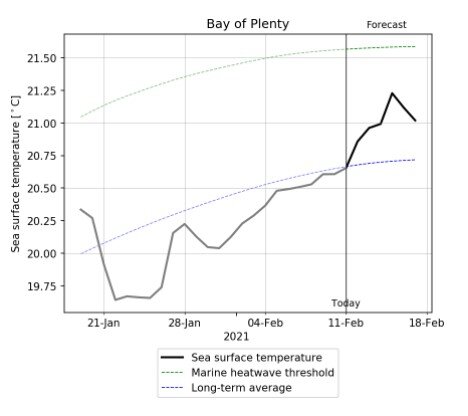NZ’s first marine heatwave forecast live
Seven day forecast of sea surface temperatures set up to predict marine heatwaves
As climate change affects our oceans, marine heatwaves are likely to become more common and intense in New Zealand waters. They can have severe effects on ocean life, impacting productive ocean industries including aquaculture and fisheries. As a New Zealand first, the Moana Project is using advanced ocean modelling to forecast when and where marine heatwaves are likely to occur. The forecasts are also being made freely available to researchers, public and industry.
Forecast map of ocean surface temperature for the upcoming 7 days
A marine heatwave is defined as ocean temperatures warmer than 90% of the temperatures experienced for that location and time of year for the last 25 years. Looking specifically at six coastal regions in New Zealand, we are forecasting ocean surface temperatures a week ahead.
‘Our models show past, present and future ocean temperatures,’ explains University of Otago’s Dr Robert Smith who is supervising research into marine heatwaves in the Moana Project. ‘By comparing the forecasted temperatures to historical data, we can monitor and predict when and where the water is getting unseasonably warm.’
Although many New Zealanders don’t mind higher than normal ocean temperatures for the holiday season, there is a darker side to marine heatwaves. ‘Warmer than normal temperatures may cause large-scale movement of fish stocks, they can lead to harmful algae blooms and can stress or even kill valuable aquaculture species such as salmon and mussels. By forecasting marine heatwaves, we hope to provide warning to our important ocean industries and coastal communities,’ says Dr. Smith.
The Moana Project is investigating marine heatwaves in some depth, explains Science Lead Dr Joao Souza from MetOcean Solutions. ‘We have two PhDs and one postdoctoral fellow working on marine heatwaves, and this forecast was produced with the help of Dr Carine Costa and Phellipe Couto of MetOcean Solutions,’ says Dr Souza. ‘We are using observations and numerical models to better understand the causes and increase the predictability of marine heatwaves around New Zealand. This will help us to forecast these extreme events with more certainty and give the public a warning. While the present tool gives us a short range forecast up to 7 days, we are looking into ways to extend this to a few months using Machine Learning techniques.’
The new marine heatwave forecasting tool can be accessed at www.moanaproject.org/marine-heatwave-forecast where a national forecast can be found as well as forecasts for selected sites: Cape Reinga, Hauraki Gulf, Bay of Plenty, Chatham Islands, Cook Strait, Christchurch, Fiordland and Dunedin. For these sites, graphs show sea surface temperature conditions for the past three weeks and a forecast for the next seven days.
Left: Ocean surface temperature graph for the Bay of Plenty showing conditions of the last three weeks (thin line) and the forecast for the next seven days (thick line).
ABOUT: The Moana Project is a 5-year $11.5 million MBIE Endeavour ocean research initiative. It aims to improve understanding of coastal ocean circulation, connectivity and marine heatwaves to provide information that supports New Zealand’s seafood industry. The project includes outstanding research organisations in New Zealand and overseas, and partners with Whakatōhea iwi to support their rohe moana interests in the Bay of Plenty.



